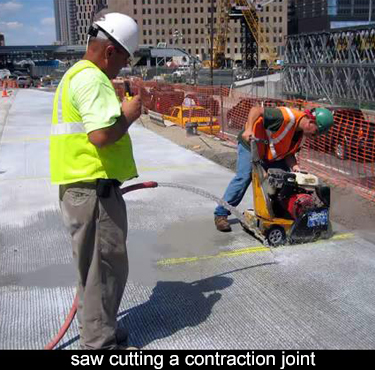The popcorn layer gets compacted, but nevertheless, even with the compaction, it remains porous. The goal is always to have a porous layer underneath the finished pavement. You never want water collecting there that results in a kind of a pumping action on the pavement. It's subjected to freezing and thawing. So the idea of continuously draining the water away from the underside of the pavement that is the most desirable end product, and the popcorn has been found to be a very, very effective way to construct a porous sub-base that remains porous over time.
 Here's a view of the saw cutting operation to construct the construction joints. Before the concrete pavement is placed, there are baskets of dowels that are placed at about 15 foot intervals at the location of the construction joint. The concrete is then placed, and the saw cut is made to force a crack, a controlled crack, at the location of the dowels - or at the location of the construction joint.
Here's a view of the saw cutting operation to construct the construction joints. Before the concrete pavement is placed, there are baskets of dowels that are placed at about 15 foot intervals at the location of the construction joint. The concrete is then placed, and the saw cut is made to force a crack, a controlled crack, at the location of the dowels - or at the location of the construction joint.
This has to be done rather quickly, because the concrete wants to shrink as it cures. On a hot day, you might place the concrete in the morning and then after lunch, do the saw cutting. During the winter, it would probably be done the following morning. This looks like a hot day and this was probably done at the same day that the concrete was placed. The blade is a diamond-tipped blade, and it needs water for cooling. At the same time, the water is very helpful because it controls any dust.
Here's an edge view. You can see that controlled crack is taken place exactly where the sawcut was made. You can see that the concrete shrinks. There's no question, It shrinks a measurable amount and this might be only after the first few hours. It continues to shrink over a lifetime, but at a much slower rate.
To avoid cracks in the concrete, you create these controlled cracks at regular intervals. The goal is that, between the controlled cracks, no further cracking will take place. After you saw cut the joint, you create a kind of a groove an opening, and that needs to be sealed. This photo shows the finished product. The Joint has already been sealed and the controlled crack is very evident.
 Here's a view from above, showing the area that we've been progressing. In this view, the pavement is finished and placed in service. This is a nice view of the pedestrian crossing or the pedestrian walkway. When you place the pavement, you omit this area, and you come back later. In this case, it's filled in with colored concrete to differentiate it from the adjoining pavement. Now southbound traffic and Northbound traffic are on new pavement, which immediately opens the adjoining area to construct the next elements of the pavement. The cycle will continue until all of the new pavement has been placed.
Here's a view from above, showing the area that we've been progressing. In this view, the pavement is finished and placed in service. This is a nice view of the pedestrian crossing or the pedestrian walkway. When you place the pavement, you omit this area, and you come back later. In this case, it's filled in with colored concrete to differentiate it from the adjoining pavement. Now southbound traffic and Northbound traffic are on new pavement, which immediately opens the adjoining area to construct the next elements of the pavement. The cycle will continue until all of the new pavement has been placed.
Here is a summary. The upper slide is the beginning of this phase of construction, and the lower slide shows this area being completed and placed in service. Approximately, seven months have elapsed. This is a longer duration than the first cycle of work. I believe, in the second cycle, there are two reasons for this. One is, increased complexity of the utility work. The other is, the fact that much of this work, or at least two or three months of this work, took place during the winter.
There are certain elements of construction that can be done very effectively through the winter, but when you're doing this kind of surface work, the winter has a tremendous impact. You need to really work in dry conditions and, therefore, during the winter, the activities are somewhat limited, I think, taken together, those two factors have slowed the progress of this second phase. Still, under the circumstances and, given the ongoing need to address problems uncovered at the site, I think the progress is excellent.